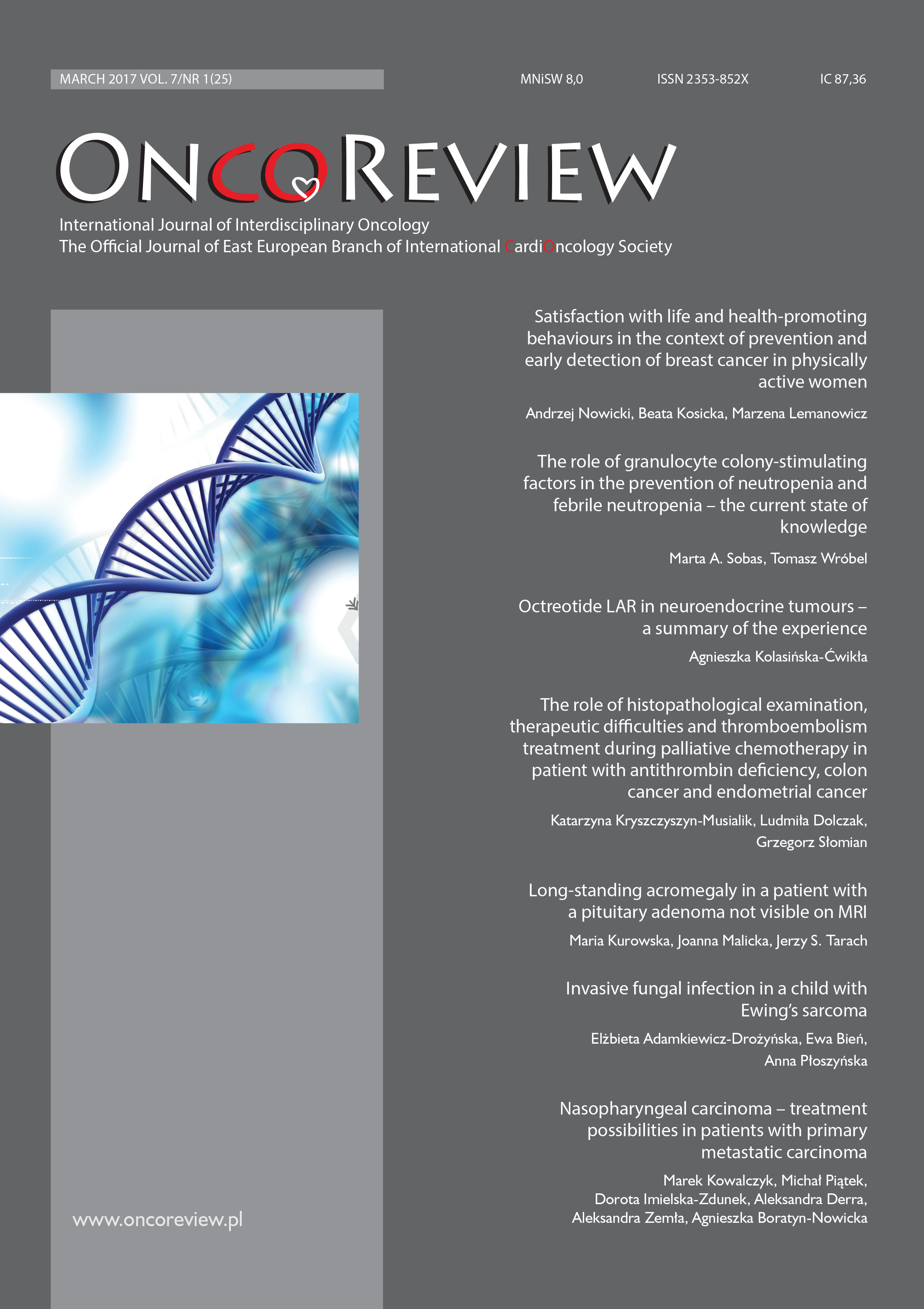Long-standing acromegaly in a patient with a pituitary adenoma not visible on MRI Case report
Main Article Content
Abstract
Introduction: Acromegaly in the course of a pituitary microadenoma or neuroendocrine GHRH-secreting tumour (GHRH, growth hormone-releasing hormone) invisible on MRI is very rare.
Objective: To present the difficulties in determining the cause behind an excessive production of the growth hormone in a patient suffering from long-standing acromegaly, without a pituitary focal lesion that would be visible on MRI.
Case report: The authors describe a case of a 69-year-old female with acromegaly, diagnosed 22 years earlier based on the typical somatic symptoms, and confirmed by the elevated concentration of insulin- like growth factor type 1 and lack of growth hormone suppression in the oral glucose tolerance test. The initial MRI scan (1994) had revealed a hypoechogenic 2 x 3 mm lesion in the anterior lobe of the pituitary gland, whose presence was not reported in the subsequent MRI tests. As ectopic GHRH or growth hormone secretion was suspected, a neuroendocrine tumour was searched for. The 47.7 × 54 × 35.7 mm tumour, located in the thoracic outlet, accumulating tektreotide in receptor scintigraphy, turned out to be a nodular goitre on histopathology. Due to the undetermined location of the source of growth hormone overproduction, failure to measure GHRH levels, and the patient’s lack of consent to undergo sella turcica exploration, long-acting release octreotide had been used for many years to manage the patient’s condition.
Conclusion: The long-lasting and ineffective search for a neuroendocrine tumour producing GHRH or growth hormone as well as the absence of a focal lesion in the repeated MRI scans render it impossible to unequivocally determine the cause of the patient’s acromegaly, and illustrate the difficulties in discovering the source of growth hormone overproduction.
Downloads
Metrics
Article Details

This work is licensed under a Creative Commons Attribution-NonCommercial 4.0 International License.
Copyright: © Medical Education sp. z o.o. This is an Open Access article distributed under the terms of the Attribution-NonCommercial 4.0 International (CC BY-NC 4.0). License (https://creativecommons.org/licenses/by-nc/4.0/), allowing third parties to copy and redistribute the material in any medium or format and to remix, transform, and build upon the material, provided the original work is properly cited and states its license.
Address reprint requests to: Medical Education, Marcin Kuźma (marcin.kuzma@mededu.pl)
References
2. Trybek T, Kowalska A. Pituitary adenoma occurring with acromegaly coexisting with partially empty sella syndrome. OncoReview 2015; 5(4): A160-163. https://doi.org/10.5604/20828691.1189744.
3. Lonser RR, Kindzelski BA, Mehta GU et al. Acromegaly without imaging evidence of pituitary adenoma. J Clin Endocrinol Metab 2010; 95(9): 4192-4196. https://doi.org/10.1210/jc.2010-0570.
4. Daud S, Hamrahian AH, Weil RJ et al. Acromegaly with negative pituitary MRI and no evidence of ectopic source: the role of transphenoidal pituitary exploration? Pituitary 2011; 14: 414-417. https://doi.org/10.1007/s11102-009-0205-z.
5. Khandelwal D, Khadgawat R, Mukund A, Suri A. Acromegaly with no pituitary adenoma and no evidence of ectopic source. Indian J Endocr Metab 2011; 15: 250-252. https://doi.org/10.4103/2230-8210.84878.
6. Ghazi AA, Amirbaigloo A, Dezfooli AA et al. Ectopic acromegaly due to growth hormone releasing hormone. Endocrine 2013; 43(2): 293-302. https://doi.org/10.1007/s12020-012-9790-0.
7. Garby L, Caron P, Claustrat F et al; GTE Group. Clinical characteristics and outcome of acromegaly induced by ectopic secretion of growth hormone-releasing hormone (GHRH): a French nationwide series of 21 cases. J Clin Endocrinol Metab 2012; 97(6): 2093-2104. https://doi.org/10.1210/jc.2011-2930.
8. Borson-Chazot F, Garby L, Raverot G et al; GTE Group. Acromegaly induced by ectopic secretion of GHRH: a review 30 years after GHRH discovery. Ann Endocrinol (Paris) 2012; 73(6): 497-502. https://doi.org/10.1016/j.ando.2012.09.004.
9. Ozkaya M, Sayiner ZA, Kiran G et al. Ectopic acromegaly due to a growth hormone-secreting neuroendocrine-differentiated tumor developed from ovarian mature cystic teratoma. Wien Klin Wochenschr 2015; 127(11-12): 491-493. https://doi.org/10.1007/s00508-015-0775-x.
10. Doppman JL, Miller DL, Patronas NJ et al. The diagnosis of acromegaly: Value of inferior petrosal sinus sampling. Am J Roentgenol 1990; 154(5): 1075-1077. https://doi.org/10.2214/ajr.154.5.2108545.

